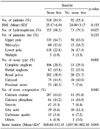Abstract
Purpose
We performed this study to evaluate the outcomes and complications of percutaneous nephrolithotomy (PCNL) at a single institute with a large series.
Materials and Methods
We reviewed the medical records of 610 patients who underwent PCNL between March 1995 and June 2008 for staghorn calculi in 139 (22.8%), partial staghorn calculi in 104 (17.0%), renal pelvis stone in 222 (36.4%), proximal ureter calculi in 60 (9.8%), and calculi within a caliceal diverticulum in 85 (13.9%) patients. Stone-free status was defined as no visible residual calcification or remnant calcification smaller than 4 mm in diameter (clinically insignificant residual fragment) on a plain KUB (X-ray examination of the kidney, ureter, and bladder) image. Characteristics of the stones, operation time, stone-free rate, and complications were evaluated.
Results
Initial stone burden was 665.9±600.6 mm2. Average operation time was 103.2±58.6 minutes. The mean hospital stay was 7.9 days. The stone-free rate was 84.9%, and ancillary procedures were required in 66 patients (10.8%), including 34 (5.6%) second-look PCNL and 26 (4.3%) ureteroscopic procedures. In the univariate analysis for prediction of stone-free rate, hydronephrosis, stone type, stone composition, and stone burden were significant prognostic factors. In the multivariate analysis, initial stone burden was the only independent factor affecting the stone-free rate. Complications were found in 95 patients (16.1%), 5 (0.8%) of whom needed embolization due to bleeding and 23 (3.8%) of whom showed pleural complications.
Figures and Tables
References
1. Rupel E. Nephroscopy with removal of stone following nephrostomy for obstructive calculous anuria. J Urol. 1941. 46:177–182.
2. Fernström I, Johansson B. Percutaneous pyelolithotomy. A new extraction technique. Scand J Urol Nephrol. 1976. 10:257–259.
3. Alken P, Hutschenreiter G, Günther R, Marberger M. Percutaneous stone manipulation. J Urol. 1981. 125:463–466.
4. Al-Kohlany KM, Shokeir AA, Mosbah A, Mohsen T, Shoma AM, Eraky I, et al. Treatment of complete staghorn stones: a prospective randomized comparison of open surgery versus percutaneous nephrolithotomy. J Urol. 2005. 173:469–473.
5. Preminger GM, Assimos DG, Lingeman JE, Nakada SY, Pearle MS, Wolf JS Jr. Chapter 1: AUA guideline on management of staghorn calculi: diagnosis and treatment recommendations. J Urol. 2005. 173:1991–2000.
6. Golijanin D, Katz R, Verstandig A, Sasson T, Landau EH, Meretyk S. The supracostal percutaneous nephrostomy for treatment of staghorn and complex kidney stones. J Endourol. 1998. 12:403–405.
7. Netto NR Jr, Ikonomidis J, Ikari O, Claro JA. Comparative study of percutaneous access for staghorn calculi. Urology. 2005. 65:659–662.
8. Marguet CG, Springhart WP, Tan YH, Patel A, Undre S, Albala DM, et al. Simultaneous combined use of flexible ureteroscopy and percutaneous nephrolithotomy to reduce the number of access tracts in the management of complex renal calculi. BJU Int. 2005. 96:1097–1100.
9. Gupta R, Kumar A, Kapoor R, Srivastava A, Mandhani A. Prospective evaluation of safety and efficacy of the supracostal approach for percutaneous nephrolithotomy. BJU Int. 2002. 90:809–813.
10. Kahn RI. Endourological treatment of ureteral calculi. J Urol. 1986. 135:239–243.
11. El-Assmy AM, Shokeir AA, El-Nahas AR, Shoma AM, Eraky I, El-Kenawy MR, et al. Outcome of percutaneous nephrolithotomy: effect of body mass index. Eur Urol. 2007. 52:199–204.
12. Sergeyev I, Koi PT, Jacobs SL, Godelman A, Hoenig DM. Outcome of percutaneous surgery stratified according to body mass index and kidney stone size. Surg Laparosc Endosc Percutan Tech. 2007. 17:179–183.
13. Tefekli A, Ali Karadag M, Tepeler K, Sari E, Berberoglu Y, Baykal M, et al. Classification of percutaneous nephrolithotomy complications using the modified clavien grading system: looking for a standard. Eur Urol. 2008. 53:184–190.
14. Lee WJ, Smith AD, Cubelli V, Badlani GH, Lewin B, Vernace F, et al. Complications of percutaneous nephrolithotomy. AJR Am J Roentgenol. 1987. 148:177–180.
15. Yoo SH, Lee TY. Percutaneous nephrolithotomy: complication and management. Korean J Urol. 1997. 38:701–706.
16. Hwang TK, Hong YK. Complications of percutaneous endoscopic surgery and the effect of surgical technique on complications. Korean J Urol. 1996. 37:903–909.
17. Segura JW, Patterson DE, LeRoy AJ, Williams HJ Jr, Barrett DM, Benson RC Jr, et al. Percutaneous removal of kidney stones: review of 1,000 cases. J Urol. 1985. 134:1077–1081.
18. Davidoff R, Bellman GC. Influence of technique of percutaneous tract creation on incidence of renal hemorrhage. J Urol. 1997. 157:1229–1231.
19. Stoller ML, Wolf JS Jr, St Lezin MA. Estimated blood loss and transfusion rates associated with percutaneous nephrolithotomy. J Urol. 1994. 152:1977–1981.
20. Munver R, Delvecchio FC, Newman GE, Preminger GM. Critical analysis of supracostal access for percutaneous renal surgery. J Urol. 2001. 166:1242–1246.
21. Heggagi MA, Karsza A, Szüle E Jr. Use of different types of dilator systems in the prevention of complications of percutaneous (PC) renal surgery. Acta Chir Hung. 1991. 32:365–369.
22. Safak M, Gögüs C, Soygür T. Nephrostomy tract dilation using a balloon dilator in percutaneous renal surgery: experience with 95 cases and comparison with the fascial dilator system. Urol Int. 2003. 71:382–384.
23. Lew JH, Lee TY. Clinical observation on percutaneous nephrolithotomy. Korean J Urol. 1988. 29:245–252.
24. Michel MS, Trojan L, Rassweiler JJ. Complications in percutaneous nephrolithotomy. Eur Urol. 2007. 51:899–906.
25. Stening SG, Bourne S. Supracostal percutaneous nephrolithotomy for upper pole caliceal calculi. J Endourol. 1998. 12:359–362.




 PDF
PDF ePub
ePub Citation
Citation Print
Print









 XML Download
XML Download